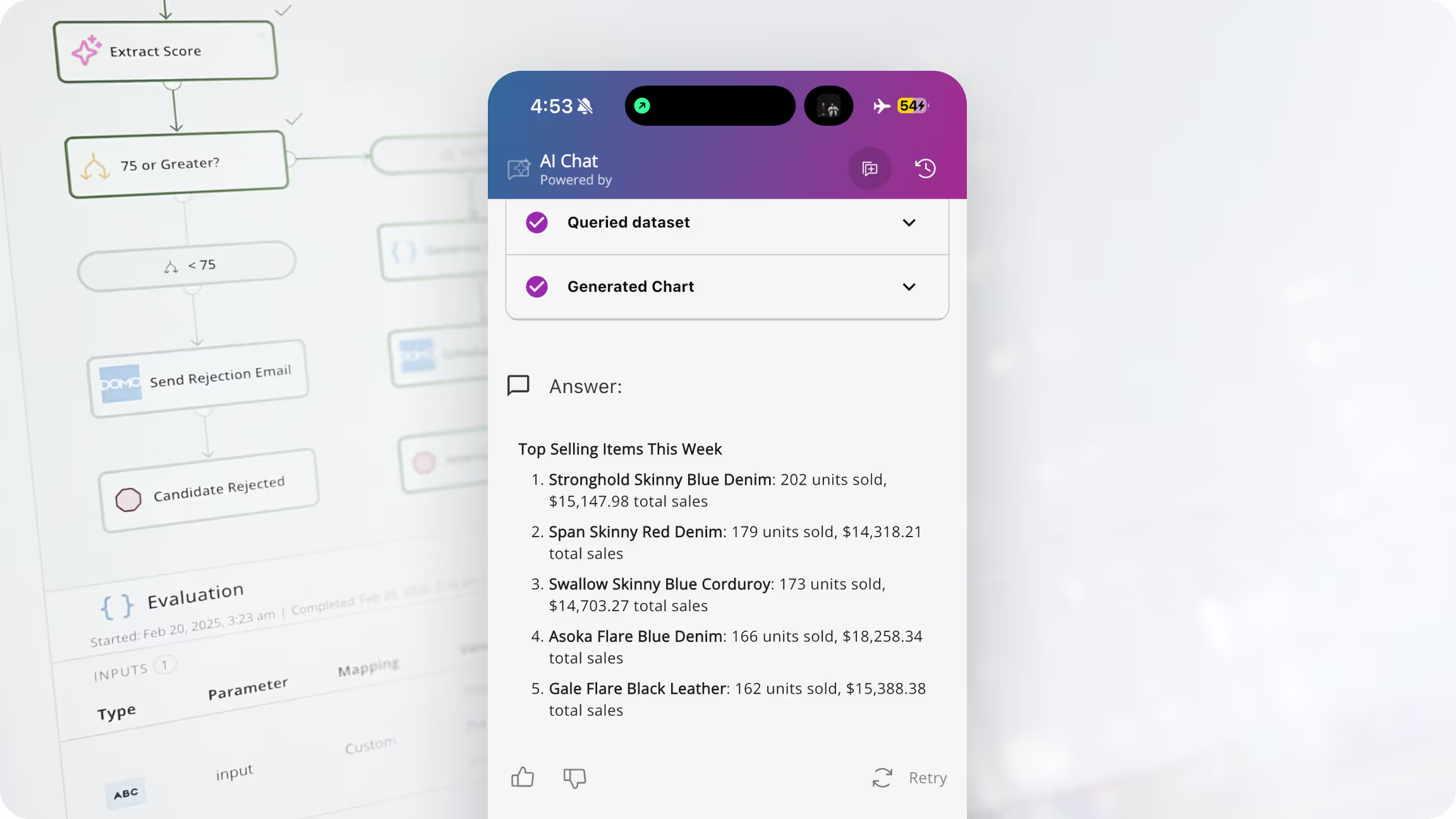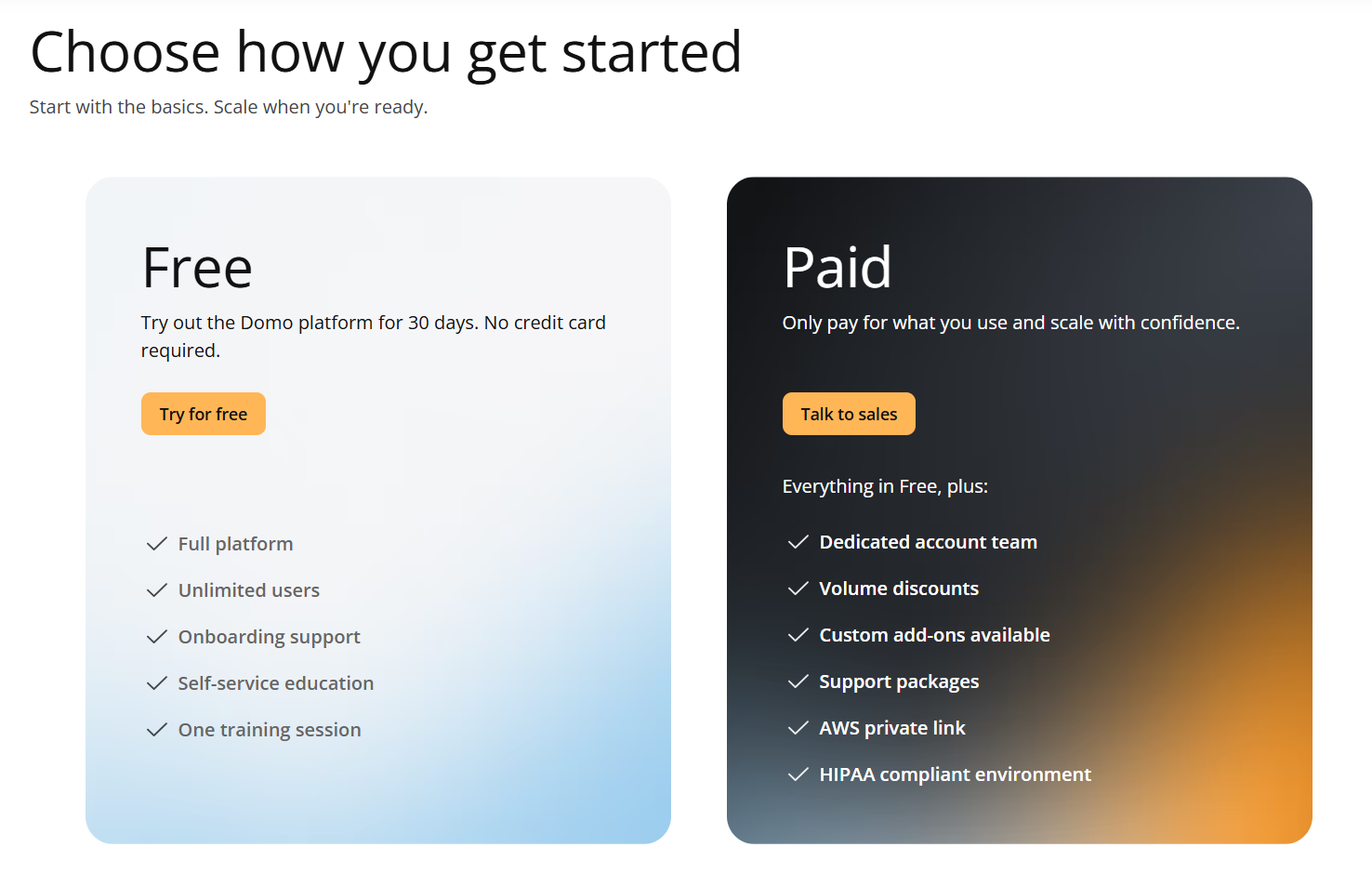Build your first embedded data product now. Talk to our product experts for a guided demo or get your hands dirty with a free 10-day trial.
Looking for a business intelligence tool in 2026 can feel like looking for a weight loss product. There are many of them out there, each making grand promises, and trying it out requires hefty investments and a likelihood of disappointment. One of those choices is Domo, a tool that promises real-time insights that lead to better decision-making.
Today, we take a look at Domo for data analytics and investigate its pros and cons.
Domo is a powerful BI tool that helps business users connect their data, visualize insights, and automate workflows in one place. Built for both technical and non-technical users, it combines traditional analytics with AI assistance, predictive modeling, and no-code dashboard creation.
Its modern platform lets you connect your data from over a thousand sources, including Snowflake, Databricks, AWS, Google BigQuery, and Microsoft Azure. Thanks to its hybrid architecture, Domo integrates seamlessly with cloud data warehouses and on-premise systems, letting teams work with live data instead of static reports.

Data visualization sits at the core of Domo’s experience. The platform includes more than 150 chart types and dataflows for building interactive dashboards and reports. However, while this variety looks appealing on paper, users often say that customization is limited and layout flexibility could be improved.
According to G2 and Gartner reviews, competitors like Power BI and Tableau still offer more control over design and formatting. That said, Domo remains a solid entry-level choice for teams who want a BI software solution that’s quick to deploy and easy to share across departments.

Domo’s performance varies depending on dataset size and dashboard complexity. Users appreciate fast queries on smaller reports and the ability to monitor live data through real-time dashboards. But as datasets grow, many note delays when visualizations refresh or when multiple dataflows run simultaneously.
Its proprietary Magic ETL feature helps speed things up by letting users clean, transform, and join data visually, without needing to use SQL. Still, for large-scale analytics or embedded use cases, some teams report that Domo can feel heavy compared to lighter BI alternatives.
Get The Free Guide
DOWNLOAD NOW!
How to build a winning SaaS analytics experience

One of Domo’s biggest advantages is its extensive library of data connectors. The tool integrates with more than 1,000 platforms, covering CRMs, marketing apps, ERPs, and cloud databases. That makes it a favorite for organizations managing multiple data systems that want a single view of performance metrics.
Whether you pull from data warehouses like Snowflake or BigQuery, or APIs from Salesforce and Google Analytics, Domo simplifies access through its Appstore. The system’s Magic ETL and drag-and-drop interface make it easy to set up automated dataflows - perfect for analysts who want to focus on insights rather than manual prep.
Domo.AI adds another layer with AI agents, automated insights, and natural-language chat that helps you explore data conversationally. Business users can ask questions using plain English instead of SQL and get instant charts or predictive insights.
While the idea is compelling, understand Domo as a tool that still relies on solid data preparation. To get the best results, you’ll need well-structured dataflows and consistent modeling first. Teams with data engineers and analysts tend to get far more value from AI features than small businesses expecting plug-and-play automation.
Much like their competitors that offer automation with AI, Domo launched their own natural-language conversation AI app that helps business users unearth KPIs and metrics and do predictive analytics on their own, without any knowledge of languages like SQL or involving data science teams.

Domo has finally updated its pricing model, but transparency is still limited. The company now positions itself as a usage-based BI and analytics platform, allowing customers to “pay only for what you use.” While this sounds flexible, understanding what that means in practice still requires talking to their sales team.
Here’s what’s officially available from Domo’s 2025-2026 pricing page.

The Free plan lets you try out the full Domo platform for 30 days with unlimited users, no credit card required.
You get:
It’s a good option for teams who want to test how Domo works with their existing data warehouses and dashboards before committing.
Once your trial expires, you’ll need to move to a paid plan. Pricing is consumption-based, meaning you pay for how much data storage, ETL processing, and queries your team uses.
Each paid plan includes everything from the Free plan, plus:
This setup lets enterprises scale usage up or down, but it’s still far from ideal for smaller teams. Because Domo’s pricing depends on usage credits, costs can grow quickly as your organization starts to pull data from multiple sources or handle larger datasets.
Every data action inside Domo consumes credits - uploading raw data, connecting APIs, running transformations, and even refreshing dashboards. That means the more real-time insights you generate, the higher your monthly bill.
While Domo promotes predictable cost tracking through its admin dashboard, real-world reviews on G2 tell a more complex story. Customers often mention that invoices fluctuate based on usage and data activity.
For example, one enterprise reviewer highlighted that their renewal costs increased by over 1,000% in a single year, despite reduced data consumption. Others described unexpected charges tied to AI agent queries, data ingestion, and storage usage.

On the positive side, users praise Domo’s mobile app, data visualization capabilities, and the ease of connecting cloud data sources, but note that pricing transparency remains a major concern. Some small and mid-sized teams report paying tens of thousands per year after add-ons, credits, and usage fees are applied - a sharp contrast to Domo’s “pay only for what you use” marketing.
Every pricing tier includes Domo’s core capabilities:
So while Domo provides a full powerful BI suite with natural language and AI-assisted analytics, the catch is in how usage accumulates.
Domo’s pricing flexibility appeals to large enterprises, but for non-technical users or growing SaaS companies, the unpredictable consumption model can make budgeting tricky.
The UI and mobile app are polished, but the total cost of ownership often exceeds other BI platforms like Power BI, Looker, or Luzmo.
In short, Domo offers a robust platform with strong AI features and enterprise-grade integrations - but before diving in, make sure your team fully understands the cost of scaling under their “pay for what you use” approach.
Many user reviews state that Domo’s cloud-based platform is very powerful but comes with a steep learning curve. For example, if you’re building interactive dashboards and looking for help with data sources, you can turn to… Googling.
Domo customer support is reportedly really hard to reach. And once you do reach them, getting help for any tech-related issue is going to be a problem.

This means that for the most part, you’re left all alone to troubleshoot this analytics platform.
Maybe Domo offers too complex, expensive, or slow for your team of an experience, or you just want to shop around before dropping six figures on your next BI tool.
So here are some Domo competitors worth your time.
If you want a fast, intuitive, and customizable way to create, embed, and share dashboards in your software, Luzmo is a powerful BI platform that outperforms Domo in usability, scalability, and flexibility. Luzmo’s product suite - Luzmo Studio, Luzmo Flex, Luzmo IQ, and Agent APIs - covers everything from drag-and-drop dashboard creation to AI-driven insights and full developer control.
Luzmo Studio helps non-technical users design customer-facing dashboards with a modern UI and easy embedding options.
Luzmo Flex lets teams use code or SQL to deeply customize analytics experiences.
Luzmo IQ adds natural language features so end-users can ask questions and get real-time insights without needing a data scientist.
Agent APIs power seamless integration with your data sources and workflows, making it ideal for SaaS products and mobile apps.
Unlike how Domo works, with heavier setup and usage-based pricing, Luzmo provides clear, transparent pricing, instant deployment, and a free trial. It’s an excellent fit for both developers and business users who want analytics that look and feel like part of their own product. Try it for free now.

Other alternatives worth checking out:
Looker: the better choice for visualization customization. Get data-driven insights from hundreds of different chart types that you can customize according to your unique needs. The ease of use is on par with Domo, as well as the pricing.
Microsoft Power BI: if you need Excel on steroids and you’re already in the Microsoft ecosystem, this is the logical choice. Compared to Domo, it offers better performance, more customization options, vastly better customer support, and significantly better and more transparent pricing.
Qlik Sense: get this BI tool if you need superior performance through associative data models, somewhat lower pricing, and dashboards that look and feel great on mobile devices. Customer support comes in various shapes, formats, and materials and the tool is just as user-friendly as Domo. The price is not cheap, but it is better than Domo.
Sisense: just as expensive as Domo but equally easy to use. Create ad-hoc dashboards and reports quickly with the built-in drag and drop dashboard builder. It comes with a better embedded analytics offer too.
Should you get Domo or not? It depends on how big your team is, how familiar you are with data analysis and visualization, and of course, how deep your pockets are.
It has many benefits, including ease of use, access to real-time data, connectivity with thousands of data sources, and more.
But at the same time, it does not handle complex data queries well, you can’t customize visualizations fully for proper data discovery and data exploration and it’s prohibitively expensive.
To sum up, get Domo if you have extensive experience with data analytics and a team of data engineers on board that can solve any data management, modeling, and visualization problems. Also, set aside a good chunk of cash for your annual Domo invoice.
On the other hand, if you’re looking for an easy-to-use, fast, fully customizable embedded analytics platform, Luzmo is the right choice.
Don’t take our word for it - grab a free trial and get started with Luzmo today.
Build your first embedded data product now. Talk to our product experts for a guided demo or get your hands dirty with a free 10-day trial.
